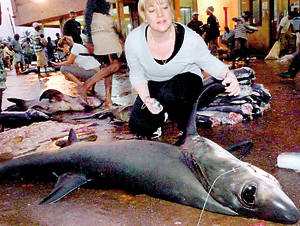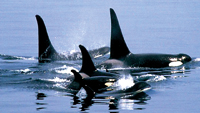News
Ban slapped on mackerel shark fishing
The over-fished Thresher Shark, or mackerel shark, has come under special protection with a Government ban on the exploitation of the endangered animal. The ban came into effect with a July 25 amendment to the Fisheries and Aquatic Resources Act.
The ban states that“no person shall catch Thresher Shark species of the family Alopiidae when engaged in any fishing operation, recreational or sport fishing,”and that “no owner or skipper of a fishing boat shall retain onboard, transship, land, store, sell or offer for sale any part or whole carcass of Thresher Shark.”

Protected shark at a local fish market
Marine biologists welcome the ban, saying overfishing has pushed the Thresher shark population to the limit.
“This is very welcome news,”shark expert Rex I. de Silva told the Sunday Times. “The ban is a move in the right direction. There are three species of Thresher Shark, and all three are found in our waters. Our fishermen refer to them collectively as ‘kasa mora’.”
‘Kasa mora’ comprises Alopias vulpinus (Thresher Shark); Alopias superciliosus (Big-eye thresher shark); and Alopias pelagicus (Pelagic thresher shark).
Mr. de Silva, who is the author of the book “A History of the Sharks of Sri Lanka”, said the Thresher shark is on the International Union for Conservation of Nature (IUCN) Red List of Threatened Fauna and Flora, and is “vulnerable to extinction.”
The Thresher shark’s life and reproduction cycle makes the species extra vulnerable to over-exploitation. The shark is slow to mature; the males reach maturity at between 10 and 15 years, while the female take longer. The shark’s life span is 20 years or more. Gestation takes around nine months, which means the female of the species can produce only a limited number of young in its lifetime. Over-fishing breaks the cycle: young threshers are killed before they can mature and raise a new generation.
The Indian Ocean Tuna Commission (IOTC) banned Thresher shark fishing two years ago. Last year, the Sunday Times called for a ban on fishing threatened species. During a visit to Sri Lanka 2011, Shark Advocates International president Sonja Fordham made specific reference to the Thresher shark in her call for an immediate ban to cover threatened species.
It was in the 80s that sharks started becoming a popular fishing target. The price of shark went up as the demand for shark fin intensified among East Asian countries, where shark fin soup is considered a delicacy. Sharks also regularly end up as a by-catch in fishing nets set up for other fish.
The amended Fisheries Act also stipulates that accidentally caught Thresher Sharks should be released into the sea by the owner or skipper of the fishing boat. There is a technique for returning a shark to the sea so the animal’s chances of survival are maximised. All instances of incidental catch and live release of Thresher Shark should be recorded in the ship’s log book.
The Thresher shark stands out from other shark species with its unusually long tail, which can be as as long as the shark’s body. The tail is also powerful enough to be used to kill prey. The Thresher is known for its athletic behaviour and its habit of“breaching”– leaping clear out of the water. Divers who have encountered the Thresher shark say the animal is non-aggressive, even gentle.
comments powered by Disqus























